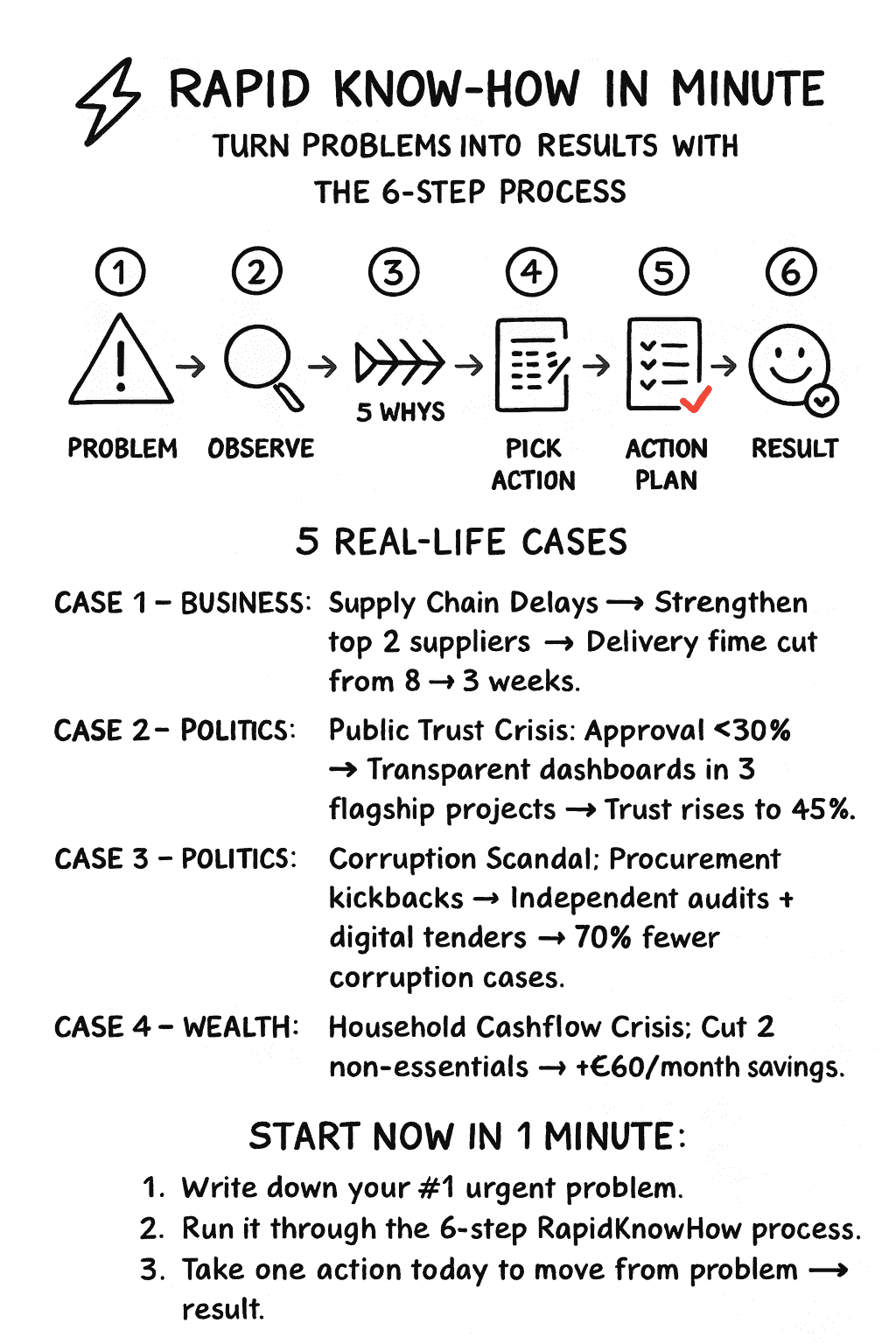The RapidKnowHow Process : Crisis Leadership Delivered
Crisis Leadership > What is the root cause > What are the Main Categories > What are the main subcategories > What are Options for Solutions > What is the feasibility of the solution > Time constraint > Resources required > Expected Effectiveness > Outcome : Ranking of Options from Best to Worst > Conclusion > Get started
Below is a comprehensive framework to analyze crisis leadership, outlining its root causes, main categories, subcategories, possible solutions, feasibility, time constraints, required resources, expected effectiveness, a ranking of these options, a conclusion, and actionable steps to get started.
Crisis Leadership Framework
1. What is the Root Cause
- Lack of Preparedness: Organizations often do not have adequate plans in place for crises.
- Poor Communication: Ineffective messages may lead to confusion and panic.
- Inadequate Leadership Skills: Leaders may lack crisis management expertise.
- Resource Constraints: Limited resources can hinder effective response.
- Resistance to Change: Organizations may be slow to adapt, exacerbating crises.
2. What are the Main Categories
- Preparedness and Planning
- Communication Strategy
- Leadership Competence
- Resource Allocation
- Organizational Culture
3. What are the Main Subcategories
- Preparedness and Planning
- Risk Assessment
- Crisis Management Plans
- Training and Drills
- Communication Strategy
- Internal Communication
- External Communication
- Media Management
- Leadership Competence
- Decision-Making Skills
- Emotional Intelligence
- Conflict Resolution
- Resource Allocation
- Financial Resources
- Human Resources
- Technological Resources
- Organizational Culture
- Creativity and Innovation
- Team Collaboration
- Responsiveness to Feedback
4. What are Options for Solutions
- Develop a Comprehensive Crisis Management Plan
- Conduct regular risk assessments and scenario planning.
- Enhance Communication Protocols
- Establish clear messaging frameworks and train staff.
- Implement Leadership Training Programs
- Focus on crisis management skills and emotional intelligence.
- Allocate Resources Effectively
- Ensure availability of necessary financial and human resources.
- Foster a Resilient Organizational Culture
- Promote adaptability, collaboration, and innovation.
5. What is the Feasibility of the Solutions
- Develop a Comprehensive Crisis Management Plan: High; requires involvement but is manageable.
- Enhance Communication Protocols: Medium to High; can be implemented with collaboration.
- Implement Leadership Training Programs: Medium; budget-dependent but high ROI on effectiveness.
- Allocate Resources Effectively: Medium; may require shifting budgets.
- Foster a Resilient Organizational Culture: Medium to High; involves long-term shifts in mindset.
6. Time Constraint
- Develop a Comprehensive Crisis Management Plan: 3-6 months.
- Enhance Communication Protocols: Immediate to 3 months.
- Implement Leadership Training Programs: 6-12 months ongoing.
- Allocate Resources Effectively:1-3 months, depending on budget and approval processes.
- Foster a Resilient Organizational Culture: Ongoing, generally takes 12 months or more for significant change.
7. Resources Required
- Develop Comprehensive Crisis Management Plan: Leadership time, consulting resources.
- Enhance Communication Protocols: Communication tools, training resources.
- Implement Leadership Training Programs: Training budget, trainers or external consultants.
- Allocate Resources Effectively: Financial analysis tools, budgeting time.
- Foster a Resilient Organizational Culture: Workshops, team-building activities.
8. Expected Effectiveness
- Develop a Comprehensive Crisis Management Plan: Very Effective; establishes a strong foundation.
- Enhance Communication Protocols: Highly Effective; mitigates misinformation and panic.
- Implement Leadership Training Programs: Effective; builds necessary skills in leaders.
- Allocate Resources Effectively: Effective; ensures response capabilities.
- Foster a Resilient Organizational Culture: Very Effective; enhances overall adaptability.
9. Outcome: Ranking of Options from Best to Worst
- Develop a Comprehensive Crisis Management Plan
- Enhance Communication Protocols
- Implement Leadership Training Programs
- Foster a Resilient Organizational Culture
- Allocate Resources Effectively
Conclusion
Effective crisis leadership hinges on preparation and adaptability.
Developing a comprehensive crisis management plan is paramount, as it lays the groundwork for efficient responses.
Follow-up actions like enhancing communication, training leaders, and fostering a resilient culture are also critical. Resource allocation is necessary but should come after establishing solid foundational practices.
Get Started
- Assemble a Crisis Management Team: Form a cross-departmental team responsible for crisis planning and response.
- Conduct a Risk Assessment: Evaluate potential risks and scenarios that your organization might face.
- Develop a Crisis Management Plan: Create a detailed action plan that includes communication strategies, roles, and protocols.
- Schedule Communication Training: Organize sessions focusing on clear and effective messaging.
- Initiate Leadership Training Programs: Provide leaders with training on crisis management and emotional intelligence.
- Promote a Culture of Resilience: Engage in team-building activities and workshops that encourage collaboration and adaptability.
By implementing this framework, organizations can significantly enhance their crisis leadership capabilities, leading to more effective responses and minimized impacts during crises.




